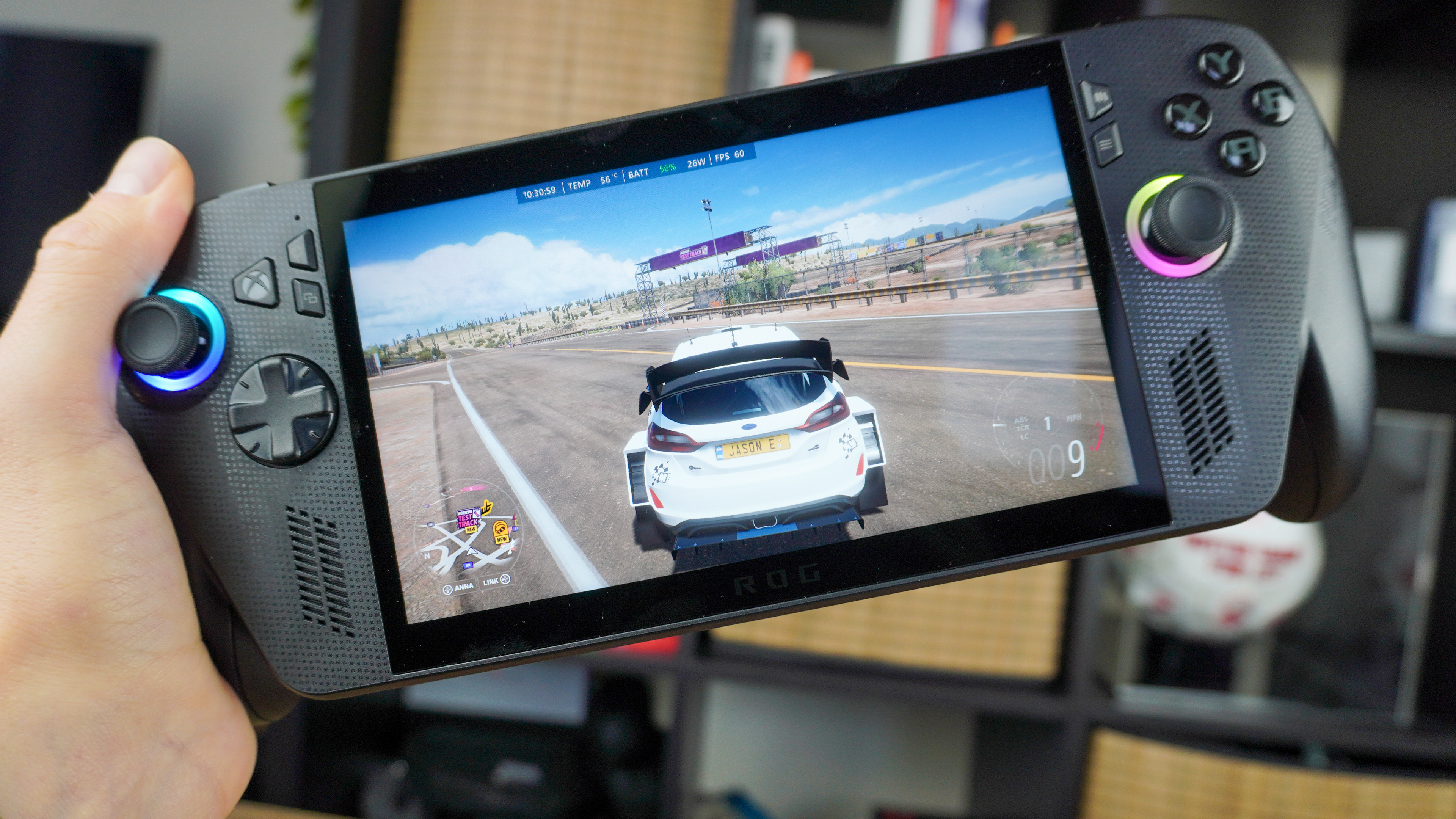Tom's Guide Verdict
Despite its high price, the PSVR 2 is an excellent way to get access to high-end VR without needing to buy a gaming PC. Behind its simple setup lies a very impressive virtual reality system.
Pros
- +
Easy to set up
- +
Great controls with haptic feedback
- +
Gorgeous display
- +
Overall excellent VR experience
- +
Access to high-end VR without a gaming PC
Cons
- -
Costs more than a PS5
- -
Controller straps are awkward
Why you can trust Tom's Guide
The PSVR 2’s spec sheet is an enviable mix of the top features seen in some of the best VR headsets, combined with proprietary Sony audio and haptic technology, all linked to a powerful game console in the PS5 with a strong developer ecosystem.
Display: 4K OLED, 2,000 x 2,040 per eye
Refresh rate: 90Hz, 120Hz
Field of view: 110 degrees
Sensors: 6-axis motion sensing system, IR camera, capacitive controller senors, IR LED position tracking
Feedback: Haptics on controllers and headset
Features: Eye tracking, adaptive triggers, Tempest 3D Audio
Connectivity: USB-C, Bluetooth 5.1
Weight: 19.8 ounces/560g
Price: $549.99 / £529.99/ €599.99 / AU$879
This not only means that I think the PSVR 2 offers one of the best VR experiences right now, but has a lot of promise in its back pocket. But is all this worth $549, which is even more than the PS5 itself? Let me tell you more in my PSVR 2 review.
It was when I reached a little too far and knocked over a rather nice glass of whisky that I knew the Sony PSVR 2 had properly immersed me in a virtual world. What might seem like a straightforward sequel to the original PSVR from 2016 is more a brand new system, as the PSVR 2 really feels like a step change for virtual reality.
PSVR 2 price and release date
The PSVR 2 was released on February 22 and can be purchased directly from Sony via the PlayStation Direct store.
With a launch price of $549.99 / £529.99/ €599.99 / AU$879, the PSVR 2 is hardly a cheap impulse buy. You’ll need to pay more than the cost of a standard PS5 in order to get a device that needs a PS5 to run. If you’re balking at that idea, then I totally understand; after all, you can get the Meta Quest 2 with its all-in-one VR system for $399 / £399 / AU$629.
But the PSVR 2’s price tag needs some context. For starters, this isn’t a headset running on mobile technology, but a more high-end affair aimed at tapping into the power that you’d really need a $1,000 plus gaming PC for. And with its specs sheet (more on that later) the PSVR 2 could trade blows with significantly more expensive VR headsets like the Vive Cosmos Elite.
I’m not going to say the PSVR 2 is good value per se, but for a total cost of some $1,050 you’re getting a high-end VR setup on a rather advanced games console.
Get instant access to breaking news, the hottest reviews, great deals and helpful tips.
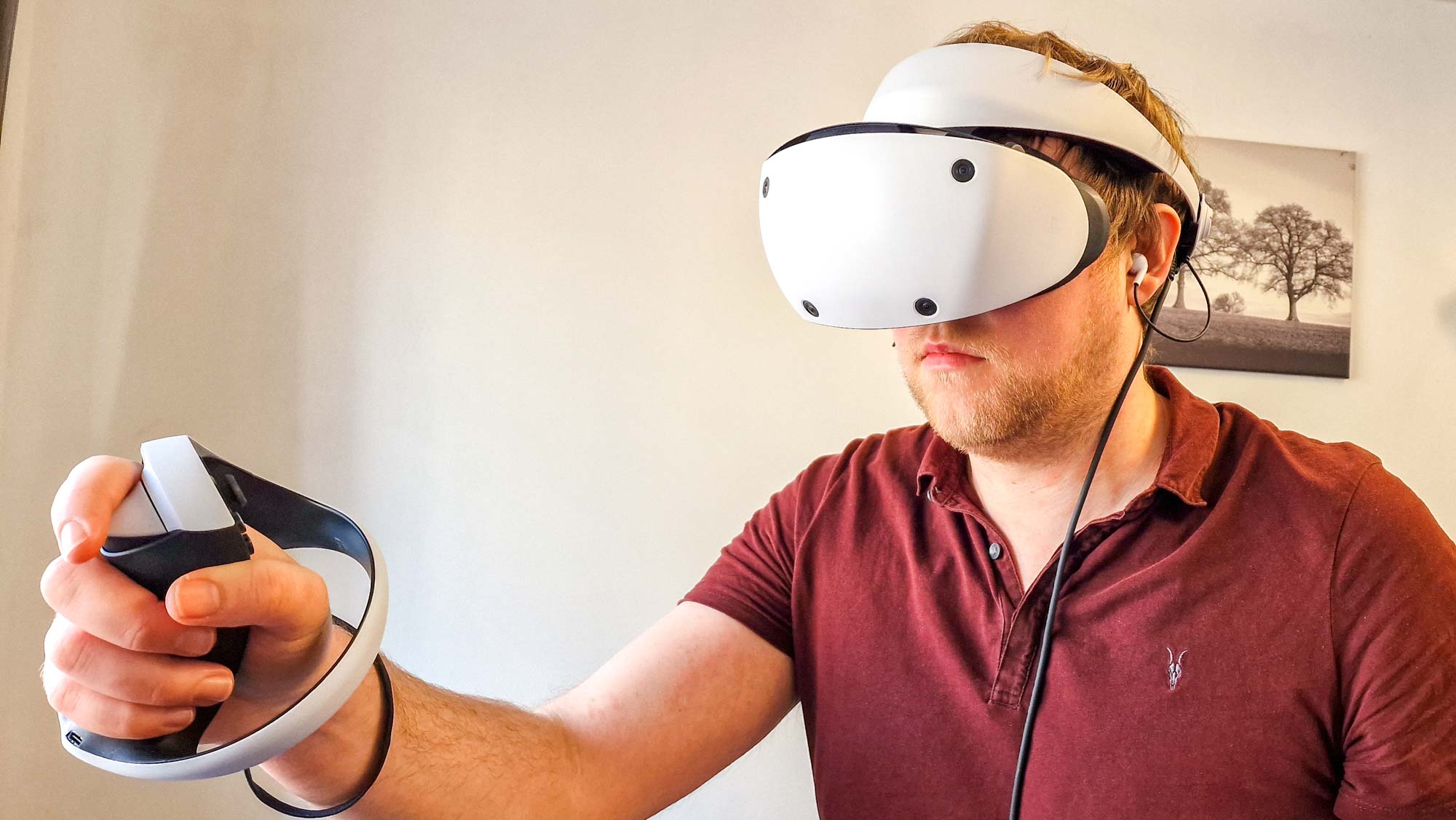
PSVR 2 design and comfort
Unsurprisingly, the PSVR 2 is an evolution of the PSVR’s design. It retains the single plastic headband of its predecessor with a few modifications, such as integrating the headband release button and the tightening wheel into one on the back of the band.
Analogue wired earbuds, which come bundled in with the PSVR 2, plug into the back of the headset’s band. And while we’re at the back, the cable that connects the PSVR 2 to the PS5 via USB-C is plumbed in on the left-hand side of the headband. The cable is relatively thin compared to those on some other VR headsets, and I found it rarely gets in the way or distracts me. But for ease of storage, I would have preferred a detachable cable; ultimately it would be great if the PSVR 2 was wireless, but the tech for low-latency VR gaming isn't quite there yet.
Inside the headband, there’s rubberized cushioning for the back of the wearer’s head and forehead. A slightly softer and more pliable rubber is used for the light shield that surrounds the wearer’s eyes. This is where the first big difference between the PSVR 2 and PSVR becomes apparent: the newer headset lets in no outside light compared to its predecessor, which I found let in enough light to be somewhat distracting. This immediately makes the PSVR 2 more immersive than the PSVR.
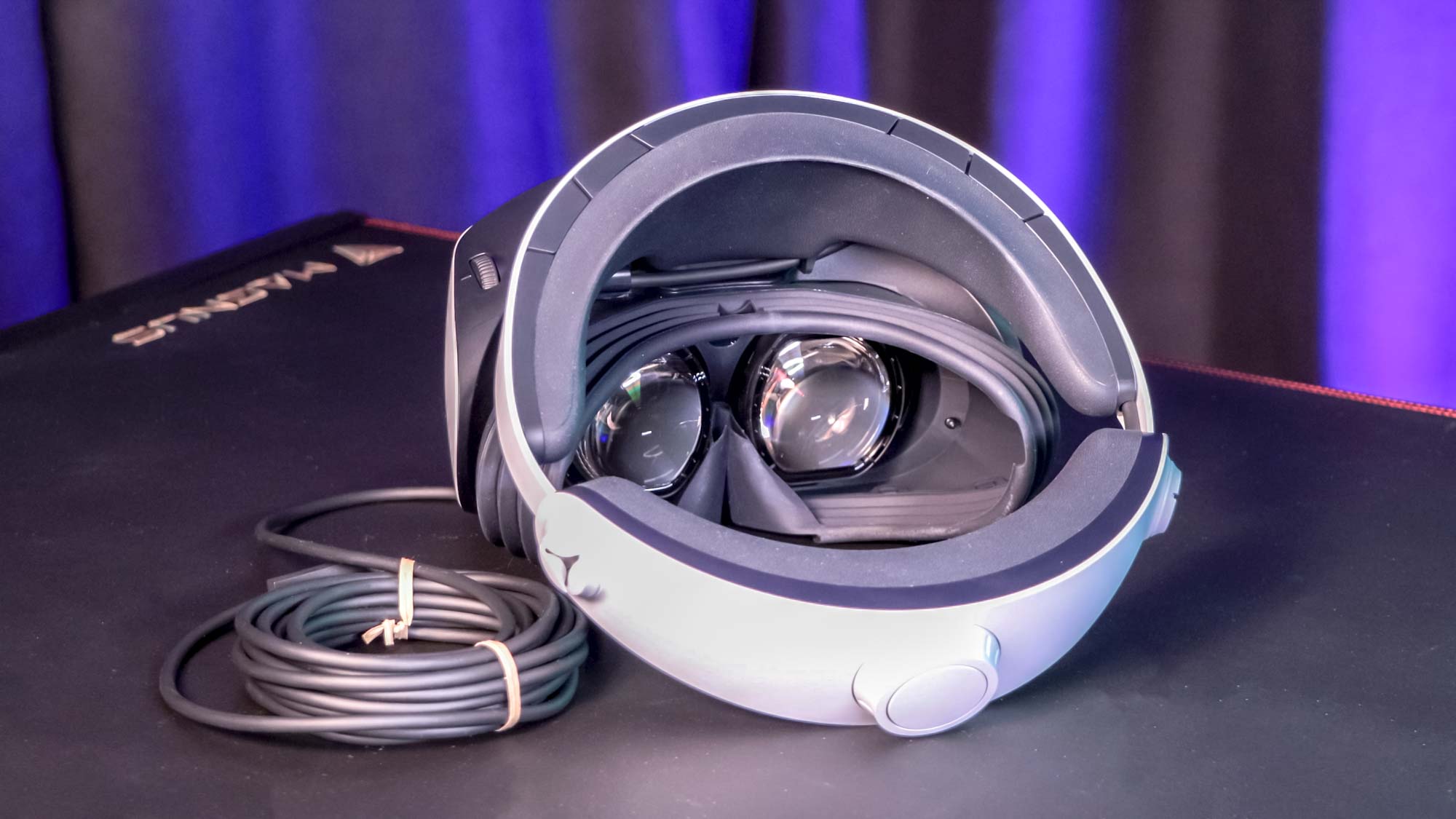
Moving to the PSVR 2’s “scope”, on its top you’ll find a button to adjust how close it is to your head and a rotary dial to adjust the lenses so that they are centered on your eyes. On the bottom, there are three buttons: one for power, one for accessing settings, and a function button that can trigger the see-through mode so you can get a glimpse of your real-world surroundings, albeit in black and white.
On the front of the scope, there are four cameras used to track the headset and scan your surroundings. Gone are the PSVR’s lights, used to sync up with an external camera as well as its black panel — instead the PSVR 2 has a clean white faceplate. Overall, the headset looks rather good and is in keeping with the two-tone aesthetic of the PS5.
It's a comfortable headset as well, and not overly heavy (it weighs around 560g/19.8oz excluding cables) though you’ll not forget that you’ve got it on. And while the rubber eye shield doesn't exactly swaddle my face in the softest of materials, I found it comfortable enough to wear for more than an hour. Granted my face got warm and I could feel the top of the shield pressing into my forehead, but a quick adjustment soon relieved that.
I found it to be one of the more comfortable VR headsets I’ve tried out and was quite happy to have it on my head for an extended amount of time.
Depending on how well you get on with VR headsets, your mileage will vary when it comes to how long you can wear the PSVR 2 for. But I found it to be one of the more comfortable VR headsets I’ve tried out and was quite happy to have it on my head for an extended amount of time. Build quality is also solid, with smooth plastics and tactile buttons, in keeping with the standard one expects from Sony.
PSVR 2 controllers

The PSVR 2’s Sense controllers could be summarized as a cross between the DualSense controller and the Quest 2 controllers. They have a similar — but larger — shape, with a pistol-like grip that extends into a ring for motion tracking. The difference here is that on the PSVR 2 the ring sits further back, almost looping around the wrist rather than sticking out at the ends of the controller like those of the Quest 2.
Combined with the two-tone look, the Sense controllers have a neat sci-fi aesthetic. I think they're rather attractive, though sometimes I’d need a split second to figure out which controller is for which hand.
On the top of each controller, there’s a clickable thumbstick, a PlayStation button, a small button for re-orienting the forward view of the headset, and a pair of buttons: circle and X for the right controller and square and triangle for the left. L1 and R1 duties are handled by a button in the controllers’ grips and sit nearly under one’s middle finger. And L2 and R2 come in the form of triggers with the same adaptive tech as the DualSense controller.
Build quality is spot-on here, with the thumbsticks and buttons offering tactile click — though both are a little smaller than those on the standard controller — and feel far superior to the Quest’s equivalent parts.
The only minor complaint is I found the wrist straps to be a little tricky to put on easily given the placement of the ring on the controllers. But they can be removed if they prove to be irritating.
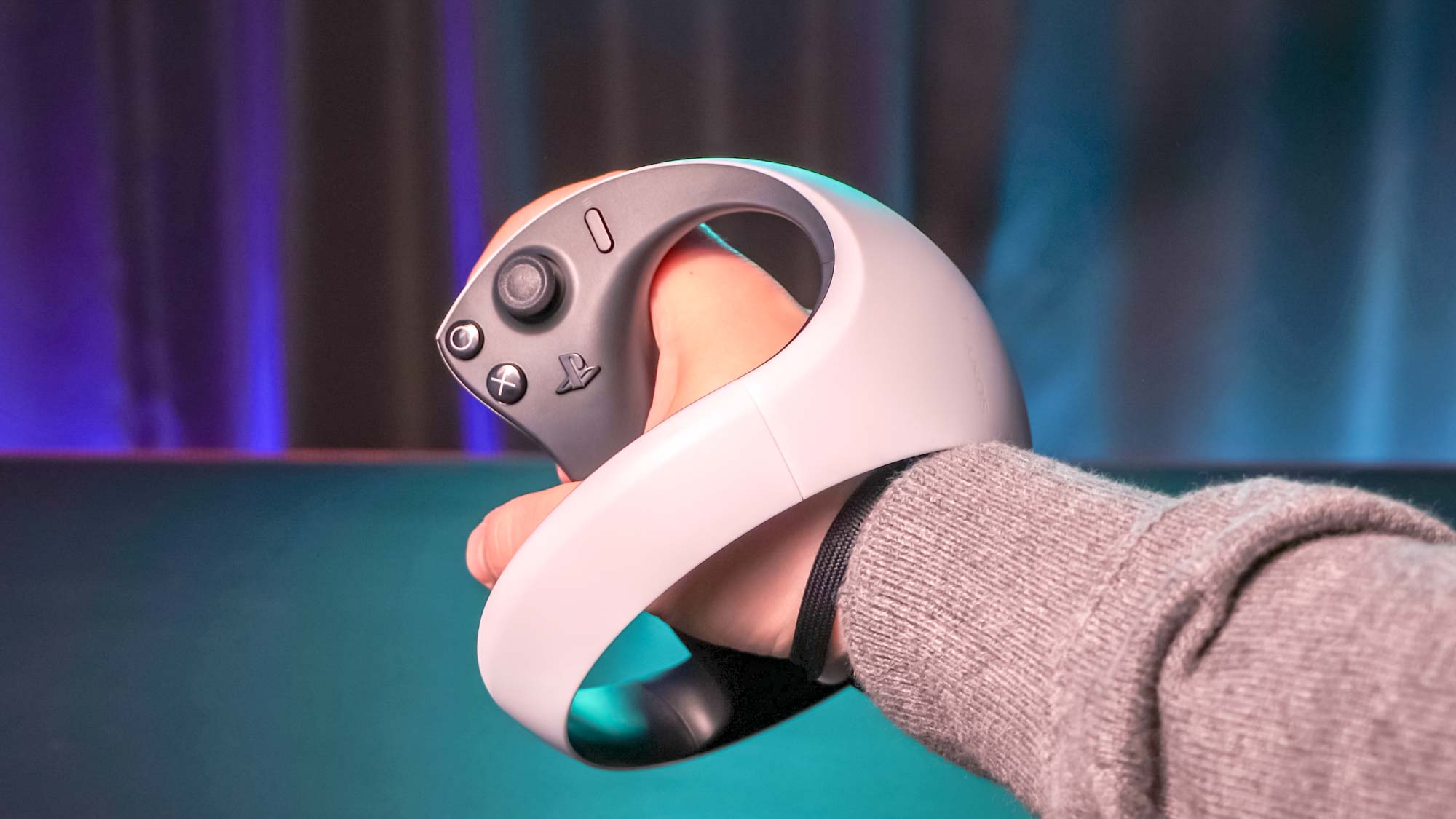
I found the motion tracking on the controllers to be excellent, with the PSVR 2 also able to detect some of my finger movements, such as when I had my hand open. But the real star of the show is the haptics.
Much like with the DualSense controller, advanced haptics are used to better convey the feel of, say, tension on a virtually drawn bowstring, making action in games feel more dynamic, realistic and thus immersive; you’ll be hearing a lot more of that world to come. Haptics are nothing new, but much like with the DualSense, I feel Sony has raised the bar here, adding an extra dimension to the VR experience compared to other systems.
And overall the PSVR 2’s controllers are far more capable than the goofy wand-like PlayStation Move controllers the PSVR was saddled with.
While not a controller, the PSVR 2 supports eye-tracking as part of the control scheme. Sony says such a feature will let players better emote reactions and emotions in games, but as this is pre-release I’ve not been able to try that out. The tech is rather slick though, allowing me to navigate to menus with a glance. This tracking is also used in some games, say to help NPCs maintain eye contact with the player; it feels like a properly next-gen feature that could open up all manner of virtual interactions in future games.
PSVR 2 display

Like the PSVR, the PSVR 2 has an OLED display. But unlike its predecessor that made do with a 1080p overall resolution, the PSVR 2’s display hits 4K by delivering 2000 x 2040 per eye. This is a huge upgrade, with everything appearing crisper and sharper on the PSVR 2. As a result, I reckon the potential for eye fatigue and headaches is substantially reduced.
The PSVR 2 also sports a 90Hz to 120Hz refresh rate display, like its predecessor. As such, the headset can support frame rates that are high enough to alleviate motion sickness experienced with some VR headsets. Now I don’t get VR-related nausea easily so this isn’t a huge deal for me, but the PSVR 2’s display feels smooth and responsive with precious little in the way of flickering or distortion to distract me from the virtual world I was in.
A 110-degree field of view (FOV) builds upon the 100 degrees of the PSVR, though an FOV over 100 degrees is perfectly acceptable. The PSVR 2’s display filled my vision and I rarely got the feeling that I was staring at a screen in some goggles rather than flitting about a virtual world.
It’s been a while since I’ve used a PSVR, but I feel the PSVR 2’s OLED is better at handling colors, which helps complement its crispness. And the OLED screen beats the LCD panels of other VR headsets I’ve used.
PSVR 2 setup
Gone is the fiddly breakout box of the PSVR, and instead the second-gen headset plugs into the USB-C port on the front of the PS5.
Setting up the PSVR 2 is mostly trivial. Gone is the fiddly breakout box of the PSVR, and instead the second-gen headset plugs into the USB-C port on the front of the PS5. To pair the controllers you need to connect them to the USB-A port on the PS5 using the bundled USB-C to Type-A cable found in the PSVR 2’s box; simply press the PlayStation button on the connected controller and in a few seconds it’s paired with the PS5 — rinse and repeat and you’re ready to continue with the setup.
Following some quick prompts on the display the PS5 is attached to, you’ll be prompted to scan your room for brightness levels — the PSVR 2 doesn't like too much light apparently, And after that, you’ll be prompted to put on the headset and follow the on-screen instructions. This will see you adjust the scope and lens position so that everything is nearly in front of you and the display is in focus — I needed to make a few tweaks due to my fussy eyes and a desire to get a snug but comfortable fit but it was all very easy.

Once up and running the PSVR 2 will then scan your room to determine the space you’ll have to move around in, even if you plan on using the headset when seated. Room-scale VR is on offer, but you’ll need a clear 2 meters by 2 meters space, which for someone like me living in a small apartment in East London isn’t really viable.
But I was able to set up a neat little space to use the PSVR 2 standing up thanks to it scanning my room to get an idea of usable space. This area can then be quickly and easily edited using the controllers if you think you’ll risk stumbling into a table or walking headfirst into a bookshelf. If the idea of such collisions leaves you feeling apprehensive, don’t worry as the headset warns wearers when they’re reaching the edge of a designated VR area; if you stray too far the headset will pull you back into your own reality.
For people fearing an initial sensory overload, a quick press of the function button on the headset will give you a decently clear pass-through view of your room — this is pretty clear for a monochrome feed, but the image can get noisy in low light.
Once set up you’ll be transported to a PlayStation menu in front of your eyes and the option to load up a PSVR 2-compatible game; just bear in mind that some games will ask for extra calibration.
Despite having pre-launch access, the PSVR 2 felt very slick on the setup side, with no real errors or jank to cause me a headache. Compared to some PC-based VR headsets, the PSVR 2 makes getting from setup into a VR game very straightforward.
PSVR 2 VR virtual experience
Despite my review unit running being pre-release, I was really impressed at how solid the whole VR experience was. Other headsets I've tested have thrown up errors or moaned about needing certain drivers; the plug ‘n’ play nature of the PSVR 2 blows this away.
Very rarely did the PSVR 2 boot me out of a game, and it was likely down to my error in passing beyond the designated VR area. Even when that happens a game will simply pause and it's dead easy to jump back into it.
Speaking of space, ideally the larger space you have for VR the better. In games where there’s a good bit of lateral movement, my arms would encroach upon the boundaries of the VR area. This wasn't enough to pause the action, but I did get minor warnings in the form of red rings around my virtual hands; fine-tuning my VR playspace should help alleviate this. People with more space or a dedicated VR area should have no problems at all.
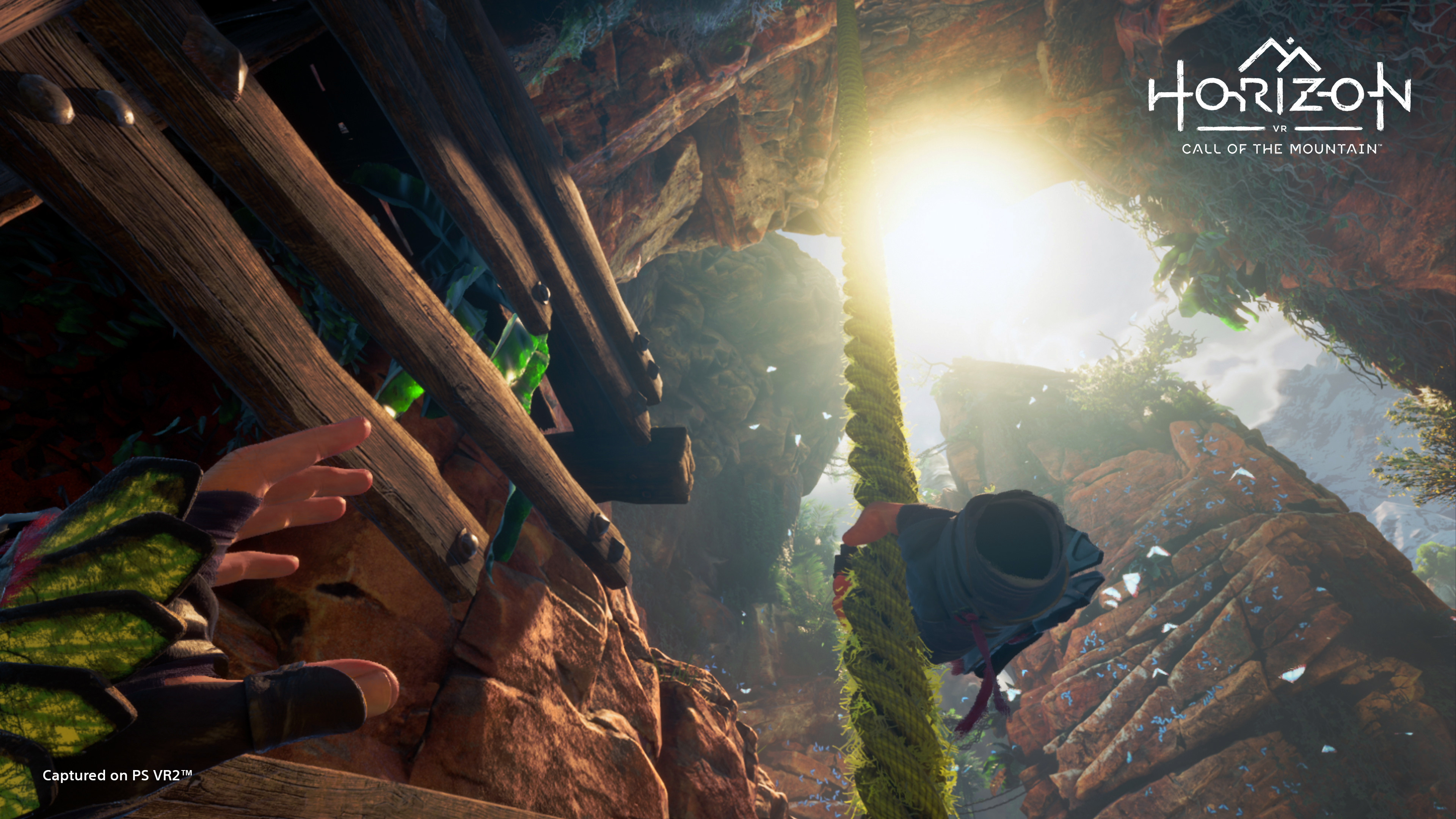
As mentioned, movement tracking is great with no discernible latency in my experience. But like with every VR system, there is a modicum of learning to be done when it comes to sussing out the feeling of depth and how far you can reach out to grab virtual objects.
My only issue with PSVR 2 as a whole is the earbuds it comes bundled with are just fine. They deliver solid audio and work with Sony’s 3D audio. But my advice would be to opt for the Pulse 3D Wireless headset as that provides a bigger soundstage and blocks out a lot of distracting noise from anything that might interrupt your VR experience.
The only thing I feel is missing for the PSVR 2 is a form of interactive menu or hub environment, as is the case with other VR platforms. Right now, all you get is a floating view of the main PS5 interface — that’s functional but hardly dynamic. I’d also like to see Sony add in a cinema-like interface so I can watch 4K Blu-rays or the likes of HBO’s The Last of Us on a virtual silver screen. This could be added as a software update after the PSVR 2’s launch, so fingers crossed for that.
PSVR 2 games
But the real thrust of the PSVR 2 will be its games. In short, existing VR games that have been ported over to the new headset work well. But I’m going to focus on Horizon Call of the Mountain, which has been made from the ground up for PSVR 2 courtesy of developer Firesprite working with Guerrilla Games.
While Call of the Mountain is a full game rather than just a short VR experience, it’s a fantastic demonstration of the PSVR 2’s tech and quality.
Without going into spoilers, Call of the Mountain sees you fill the body of Ryas, a disgraced former soldier on a journey of redemption by helping his former enemies and attempting to locate a missing person on a mountain. Of course, there are mysteries afoot that you’ll seek to uncover as you navigate the peaks of the Carja Sundom.

From my time with the game so far, plot-wise it’s standard Horizon fare; not a bad thing if you liked Horizon Zero Dawn and Horizon Forbidden West.
Almost straight away, Call of the Mountain gives you a real sense of scale, whether you're looking up, down, or towards the horizon.
Due to needing to run at 4K and a fast frame rate, Call of the Mountain can’t quite match Forbidden West in terms of sheer graphics. But it still looks great with colorful valleys, snow-capped mountains, expressive NPCs, and a good dose of volumetric effects. And thanks to PSVR 2, I’ve never felt more immersed in the post-post-apocalyptic Earth of Horizon.
With my face in the game, rather than seeing things from a third-person view, the lands of the Sundom are far more engaging. Almost straight away, Call of the Mountain gives you a real sense of scale, whether you're looking up, down, or towards the horizon. In the opening sequence, a massive Tallneck machine cuts across Ryas’ path, and I couldn’t help but stare up at it. And even though I saw it coming, I still physically ducked as a Stormbird, a large eagle-like flying machine, swooped above me.

Such things are nothing new in the world of VR. But the haptic feedback in the controllers and across the headset, combined with Sony’s Tempest 3D Audio tech, adds a level of depth to convey a sense of reality.
I could hear beams creak as I climbed them and felt a sense of connection when moving from hand-hold to hand-hold or pulling back on a bowstring. Plus the range of movement the PSVR 2 allows, had me leaning around obstacles pulling off arrow shots that would be impossible in the standard game; the tech here literally feels game-changing.
However, as much as Call of the Mountain has impressed me, it’s also set a high standard for PSVR 2 games to follow. At the time of writing, there aren’t a huge amount of other games to test the PSVR 2 with. Those that I have worked well, but are mostly ports of previous PSVR, Steam VR or Quest 2 games.
Given the number of VR games now available in general, as well as those on the original PSVR, the PSVR 2 shouldn’t be lacking for VR games; it has more than 30 set to arrive within a February to March launch window. But taking into consideration its price tag and being PS5-only, I’m hoping to see more dedicated and new PSVR 2 games that can fully tap into its technology.
With a VR update for Gran Turismo 7 and Resident Evil Village incoming, there should be some longer-form VR experiences for the PSVR 2 very soon. But I’m really hoping Sony harnesses the power of its first-party studios like Naughty Dog and Santa Monica to create brand-new PSVR 2 games. Sony says there are more than 100 PS VR2 games in development, so I’m cautiously optimistic that the PSVR 2 will see a larger volume of higher-quality games than its predecessor.
Alternatively, Sony could open up the PSVR 2 for PC connectivity, say creating a Windows-based VR interface. This isn’t unreasonable given Sony had been porting games over to the PC, but I’d not place a bet on PSVR 2 PC connectivity any time soon.
PSVR 2 verdict
The best way to summarize my experience with the PSVR 2 is I’m looking forward to putting it on again. While I’ve always enjoyed VR, that’s not really something I can say about previous VR headsets.
In many ways, the PSVR 2 combines all the best of VR tech with some of the excellent haptics and audio from the PS5, into a system that’s dead easy to use and surprisingly robust. To me, this combination immediately makes VR more compelling, especially as it integrates with my current PS5 gaming setup.
Sure the price tag is enough to make all but the richest among us pause. But if you’re interested in VR and want to elevate your PS5 experience then I think the PS VR2 is worth it.
Sure the price tag is enough to make all but the richest among us pause. But if you’re interested in VR and want to elevate your PS5 experience then I think the PSVR 2 is worth it. On the other hand obviously, for those not so keen to delve deeper into virtual worlds, the PSVR 2 might seem like an overly expensive peripheral.
However, if Sony follows through with more high-end VR games that draw upon the PS5’s power, then I think the PSVR 2 will not only offer an extra games system on top of its connected console, but also start setting a standard for other VR platforms to follow. And that is genuinely exciting.

Roland Moore-Colyer a Managing Editor at Tom’s Guide with a focus on news, features and opinion articles. He often writes about gaming, phones, laptops and other bits of hardware; he’s also got an interest in cars. When not at his desk Roland can be found wandering around London, often with a look of curiosity on his face.

